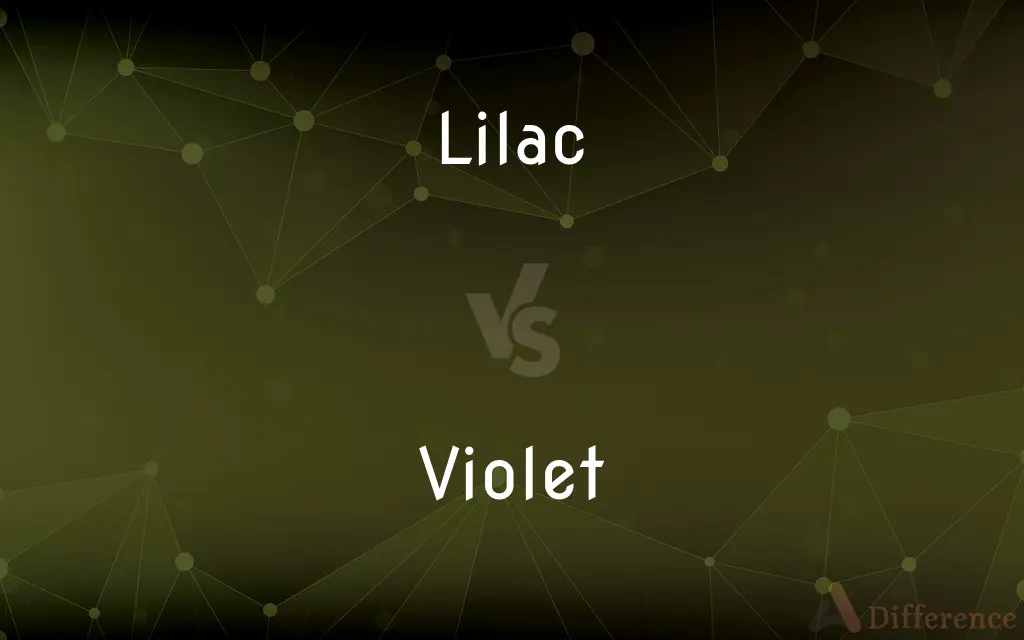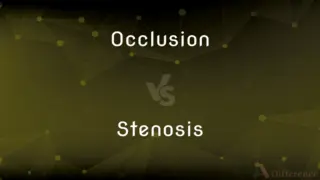Lilac vs. Violet — What's the Difference?
By Maham Liaqat & Urooj Arif — Updated on April 5, 2024
Lilac is a light purple color with a pinkish hue, often associated with the lilac flower, whereas violet is a deeper purple, closer to blue, and is one of the colors of the rainbow.

Difference Between Lilac and Violet
Table of Contents
ADVERTISEMENT
Key Differences
Lilac is derived from the lilac flower and signifies early spring, representing renewal and youthful innocence. It's a softer, lighter shade that combines purple and pink tones, suggesting a gentle, comforting presence. Violet, on the other hand, has a richer, deeper purple color that leans more towards blue, symbolizing royalty, luxury, and creativity due to its association with the violet flower and its historical use in royal garments.
In terms of color psychology, lilac is often seen as calming and nurturing, evoking feelings of romance and nostalgia. It's frequently used in bedrooms and living spaces to create a serene atmosphere. Violet, with its deeper saturation, is considered more dramatic and imaginative, often used in creative spaces to stimulate inspiration and originality.
Lilac's lighter hue makes it versatile in fashion and interior design, pairing well with neutrals and pastels for a soft, feminine look. It's popular in spring and summer collections, reflecting the bloom of its namesake flower. Violet, being bolder and more vivid, makes a statement in design and fashion, often used as an accent color to add depth and vibrancy.
In floral language, the lilac flower is associated with first love and innocence, especially the light purple variety. The color itself carries this symbolism, often used in bouquets and floral arrangements to convey affection. Violet flowers symbolize loyalty, devotion, and faithfulness, with the color embodying these qualities, making it a popular choice for gifts representing deep affection.
On the color wheel, lilac is positioned closer to pink, indicating its lighter, softer nature. Violet sits closer to blue, reflecting its cooler, more introspective qualities. This positioning influences how each color is perceived and used in color theory and design, with lilac often used for its soothing qualities and violet for its depth and intensity.
ADVERTISEMENT
Comparison Chart
Hue
Light purple with a pinkish hue.
Deeper purple, leaning towards blue.
Symbolism
Renewal, innocence, youthfulness.
Royalty, luxury, creativity.
Psychological Effect
Calming, nurturing, romantic.
Dramatic, imaginative, stimulating.
Use in Design
Soft, versatile, pairs well with pastels.
Bold, makes a statement, used as an accent.
Floral Language
First love, innocence.
Loyalty, devotion, faithfulness.
Compare with Definitions
Lilac
Associated with early spring and renewal.
The lilac blooms signaled the start of spring.
Violet
Known for stimulating imagination and originality.
A violet notebook was chosen to inspire creative writing.
Lilac
Used in design for a soft, feminine feel.
They chose lilac for the nursery to create a calming atmosphere.
Violet
A deep purple color closer to blue, visible in the rainbow.
The artist used shades of violet to add depth to the painting.
Lilac
A pale violet tone resembling the lilac flower.
The bridesmaids wore dresses in shades of lilac.
Violet
Represents loyalty and faithfulness in floral language.
Violets were included in the bouquet to signify their deep commitment.
Lilac
Represents youth and the joy of new beginnings.
The graduation party was decorated in lilac, symbolizing a new chapter.
Violet
Used as an accent color in fashion and design for vibrancy.
The designer added violet pillows to the couch for a pop of color.
Lilac
Symbolizes first love and innocence in floral language.
He gave her a bouquet of lilacs to express his budding affection.
Violet
Symbolizes royalty, luxury, and creativity.
The velvet curtains were a rich shade of violet, giving the room a regal feel.
Lilac
A Eurasian shrub or small tree of the olive family, which has fragrant violet, pink, or white blossom and is a popular garden ornamental.
Violet
Any of various low-growing herbs of the genus Viola, having short-spurred, irregular flowers that are characteristically purplish-blue but sometimes yellow or white.
Lilac
Any of various shrubs of the genus Syringa, especially S. vulgaris, which has been widely cultivated for its clusters of fragrant flowers that are usually purplish or white but may be pink, blue, or creamy yellow depending on the cultivar.
Violet
Any of several similar plants, such as an African violet.
Lilac
A pale to light or moderate purple.
Violet
The hue at the short-wavelength end of the visible spectrum, evoked in the human observer by radiant energy with wavelengths of approximately 380 to 420 nanometers; any of a group of colors, reddish-blue in hue, that may vary in lightness and saturation.
Lilac
A large shrub of the genus Syringa, especially Syringa vulgaris, bearing white, pale-pink, or purple flowers.
Violet
A plant or flower of the genus Viola, especially the fragrant Viola odorata; (inexact) similar-looking plants and flowers.
Lilac
A flower of the lilac shrub.
Violet
(figurative) A person thought to resemble V. odorata, especially in its beauty and delicacy.
Lilac
(color) A pale purple color, the color of some lilac flowers.
Violet
A bluish-purple colour resembling that of most V. odorata.
Lilac
Having a pale purple colour.
Violet
Clothes and (ecclesiastical) vestments of such a colour.
Lilac
A shrub of the genus Syringa. There are six species, natives of Europe and Asia. Syringa vulgaris, the common lilac, and Syringa Persica, the Persian lilac, are frequently cultivated for the fragrance and beauty of their purplish or white flowers. In the British colonies various other shrubs have this name.
Violet
(perfumes) The characteristic scent of V. odorata.
Lilac
A light purplish color like that of the flower of the purplish lilac.
Violet
Syn of onion.
Lilac
Any of various plants of the genus Syringa having large panicles of usually fragrant flowers
Violet
Having a bluish-purple colour.
Lilac
Of a pale purple color
Violet
Any plant or flower of the genus Viola, of many species. The violets are generally low, herbaceous plants, and the flowers of many of the species are blue, while others are white or yellow, or of several colors, as the pansy (Viola tricolor).
Violet
The color of a violet, or that part of the spectrum farthest from red. It is the most refrangible part of the spectrum.
Violet
In art, a color produced by a combination of red and blue in equal proportions; a bluish purple color.
Violet
Any one of numerous species of small violet-colored butterflies belonging to Lycæna, or Rusticus, and allied genera.
Violet
Dark blue, inclining to red; bluish purple; having a color produced by red and blue combined.
Violet
Any of numerous low-growing small-flowered violas
Violet
A variable color that lies beyond blue in the spectrum
Violet
Of a color midway between red and blue
Common Curiosities
How do lilac and violet differ in floral language?
In floral language, lilac symbolizes first love and innocence, while violet flowers represent loyalty, devotion, and faithfulness.
Why is violet associated with royalty?
Violet is associated with royalty due to its historical rarity and the expense of producing violet dyes, which were once only affordable to the wealthy.
How is violet used in fashion?
Violet is often used as an accent color in fashion to add depth, vibrancy, and a touch of luxury.
What does wearing violet signify?
Wearing violet can signify creativity, individuality, and a sense of luxury or royalty.
Can men wear lilac and violet?
Absolutely, men can wear lilac and violet as these colors transcend gender, offering elegance and vibrancy to anyone's wardrobe.
What does a gift of violet flowers mean?
A gift of violet flowers can mean a pledge of loyalty, devotion, or deep affection towards someone.
What distinguishes lilac from violet in color psychology?
Lilac is perceived as calming and nurturing, suitable for creating a serene ambiance, while violet is seen as more dramatic and imaginative, often used to stimulate creativity.
Is lilac suitable for any room in the house?
Lilac is versatile and can be suitable for any room, especially bedrooms and living spaces where a calming effect is desired.
Are lilac and violet shades of purple?
Yes, both lilac and violet are shades of purple, with lilac being lighter and pinker, and violet being deeper and closer to blue.
Can lilac and violet be used together in design?
Yes, lilac and violet can complement each other in design, with lilac providing a soft backdrop to the bolder violet, creating depth and interest.
What emotions does lilac evoke?
Lilac evokes feelings of romance, nostalgia, and the gentle joy of early spring.
How do lighting conditions affect the appearance of lilac and violet?
Lighting conditions can greatly affect how lilac and violet are perceived; natural light tends to enhance their depth and vibrancy, while artificial light may alter their hues slightly.
Is lilac considered a spring color?
Yes, lilac is considered a spring color, reflecting the bloom of lilac flowers and symbolizing renewal.
How do artists use violet in their work?
Artists use violet to add depth, contrast, and emotion to their work, leveraging its richness to draw the viewer’s attention.
Why is lilac popular in interior design?
Lilac is popular in interior design for its ability to create a soft, soothing environment, ideal for spaces meant for relaxation.
Share Your Discovery

Previous Comparison
Reviewee vs. Review
Next Comparison
Occlusion vs. StenosisAuthor Spotlight
Written by
Maham LiaqatCo-written by
Urooj ArifUrooj is a skilled content writer at Ask Difference, known for her exceptional ability to simplify complex topics into engaging and informative content. With a passion for research and a flair for clear, concise writing, she consistently delivers articles that resonate with our diverse audience.
















































